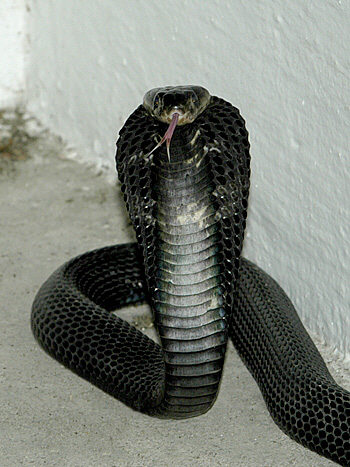 |
| Equatorial spitting cobra looking fierce |
There are currently eleven known species of spitting cobras on Earth. Their color, markings and size differ greatly between the species. The difference in size can be several feet. Some spitting cobras are only a few feet long, while the largest spitting cobra ever found was more than nine feet in length. Spitting cobras can be red, brown or black, with or without markings. However, they do have one feature in common; all spitting cobras are hooded, like the king cobra.
An interesting fact about spitting cobras is that they do not actually spit their venom; technically it is sprayed out of their fangs. After the snake uses its muscles to force the venom into its fangs, it uses a burst of air from its lungs to propel the venom out of its mouth. They do this mainly as a way to defend themselves, and they can aim their venom rather accurately when threatened. The venom that is expelled from the snakes fangs can travel up to ten feet.
Most spitting cobras are equipped with hemotoxic and neurotoxic venom. This venom is harmless if it lands on unbroken skin. However, you should be careful not to touch or spread the venom and to wash it off carefully. If the venom enters the blood stream through broken skin, it can be deadly. A spitting cobra will often aim for the eyes, which can be a problem if it hits its target. The venom can cause complete and permanent blindness if it isn’t treated properly.
Spitting cobras are also capable of delivering their venom through a bite. They will typically use this method for prey only, but the bite is dangerous for the unlucky who are on the receiving end. The large brown spitting cobra is particularly dangerous as it can potentially deliver more venom per bite than any other snake species on Earth.
The large brown spitting cobra is the most recent discovery among spitting cobra species. It is also the biggest and most deadly. Its venom is not as toxic as the king cobra, but far more can be delivered in one bite. There may be even more spitting cobras out there, just waiting to be discovered, but it is doubtful that any can deliver as much venom as the large brown.
